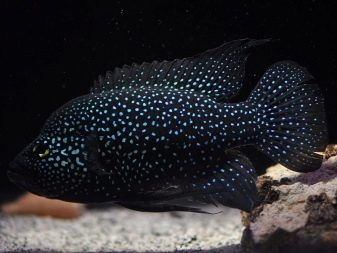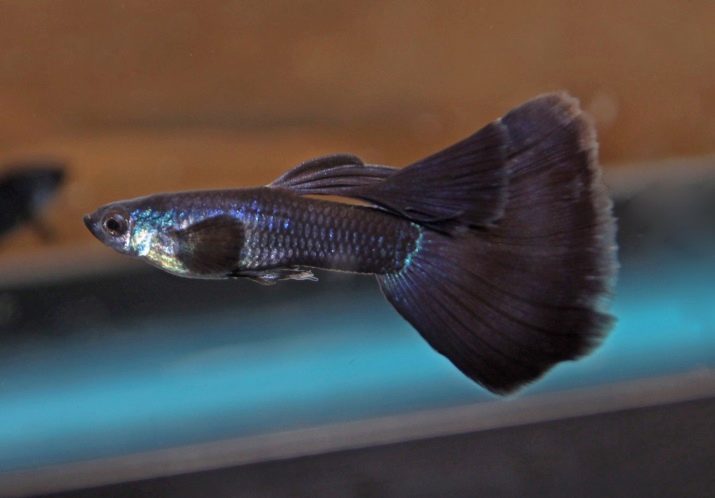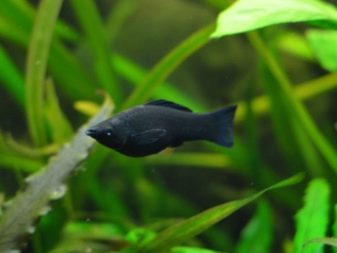Black fish in the aquarium look noble and solid, despite their seemingly boring dark color. There are not so many varieties of pure black fish, individuals with spots of a different color are more common or their scales have a shade of brown, green, etc. Let's get to know these fish better.


Large Variety Overview
Let's start with large representatives of the raven wing fish brethren.
- Antsistrus is dark. Belongs to the chain-mail catfish family. It has a flattened body with a large head, tapering to the tail. The eyes of Antsistrus are large, convex, located on top, in color they almost do not differ from the main color of the catfish. The oral cavity is round, has the shape of a sucker, is equipped with horn-shaped plate jaws, allowing you to scrape food from hard surfaces.
The color of Antsistrus is brown-olive, the belly is lighter - greenish-gray or brown. Somik is decorated with bright spots. The fins are quite large, the dorsal resembles a sail of a yacht. The size of captive in captivity is 14-16 cm.

- Bagrus is black (mystus, killer whale-changeling, catfish-changeling). A rare guest in the home aquarium, but if you try, you can find this beautiful and unusual fish in the pet store. It has an elongated torpedo-shaped body of black color with small silver inclusions, a triangular dorsal fin resembling a shark, 4 pairs of long (almost half the length of the trunk) whiskers. In the wild (and it is found in Myanmar, in the Irrawaddy river), its growth reaches 30 cm, in the aquarium conditions – no more than 20 cm.

A distinctive feature of black bagrus is his love of swimming “upside down” - belly up.

- Zebrasoma Very unusual rare fish. It has a high, flattened laterally ellipsoidal body. Large fins on the back and belly expand to the tail, giving the zebrasome an almost triangular shape. The caudal fin is small, with an even cut, resembles an isosceles triangle.
The muzzle of the fish is elongated, the eyes are large and expressive. The color is aspid, at the base of the tail there is a small white spot.
The length of the zebrasoma can grow up to 20-21 cm. In captivity does not breed.

- Black-banded surgeon fish. It got its name for the presence of an acute scalpel-like growth located in the tail region. When these fish get angry, they can launch him, causing each other cuts and scratches (which, however, are rarely fatal). The body is in the shape of an ellipse, flat on the sides, high. The ventral and dorsal fins are rounded, repeating the shape of the body.
The caudal fin resembles a crescent. The color of the surgeon is almost coal, has an olive hue. A wide white stripe runs across the base of the tail. The size of this fish is 35-40 cm.


- Pterigoplicht brocade. Another catfish. Generally speaking, it can be attributed to black-colored fish rather conditionally, since there is a bright golden mesh pattern on the entire surface of its body and on the fins. The general background is dark brown.
Like most catfish, the body of the pterigoplichitis is flattened from top to bottom, the fish has a wide head with high set eyes, and a sucker mouth. A distinctive feature is a high sail-like dorsal fin up to 15 cm long. The captive pteric can grow up to 30 cm (in natural conditions, it is twice as large).

Variety of small fish
Now you should get acquainted with smaller ones, however, no less interesting black fish.
- Black swordsman. Infrequently encountered aquarium inhabitant. Strictly speaking, this variety is a hybrid of a green swordsman and black patsilia. It has a thick black color with a greenish or bluish tint.
The eyes are silvery, the pupil is dark, large. The size of the individual is 8-10 cm.

- Black Molly (Molliesia). The favorite of many aquarists. It has a coal-black body color, a crest-like dorsal fin, and the tail fin is similar to a lyre or a cut semicircle. The size of the black molly is a maximum of 10 cm, the females are larger than the males.
Mollinesia refers to viviparous fish, which makes it an interesting inhabitant of the aquarium.

- Pecilia is black. Pretty small fish, reaching a length of only 2.5-3.8 cm. Its color is not pure black: the muzzle, abdomen, dorsal and caudal fins are painted in orange or silver. Yes, and on the scales itself there is a greenish tint. Through selection and hybridization with swordsmen, new interesting representatives of the species appear, which have a variety of shades.

- Black telescope (black moor, black prince). This fish is famous for its unusual appearance. It is a kind of goldfish. It has a small but dense body, with an outstanding round belly and a "hump" on the back. The fins are veiled, elongated.
A distinctive feature of the telescope is its huge bulging eyes, which, incidentally, are pretty poorly seen. The color of the Moor is velvety black, sometimes individuals with a greenish or purple tint are found. The size of the telescope is up to 10 cm in length.

- Black guppies. They are representatives of live-bearing fish. Among the black guppies, there are several varieties. Guppy the black prince is characterized by a coal-black body color, which smoothly turns into silver on the crown. By the way, such a coloring is inherent only to males, “ladies” are painted much more modestly, only their tail is black.
The guppy black monk has a charcoal body shimmering in electric blue. Abdomen is light. Females have black tail, beige-silver color.

Moscow blue guppies are one of the most beautiful representatives of this variety. Strictly speaking, they are not black, but simply very dark, with bright tints of blue, emerald, purple.
Guppy Tuxedo (Guppy Tuxedo) interesting in that they seem to be wearing a dark tuxedo starting from the side fins. The head, gills, back and abdomen are painted in pearl silver to the middle of the body.
Guppy panda. Refers to black varieties, although the main color is greenish-gray or bluish-ink. The back is darker than the front, the fins are also dark.



- Black angelfish. There are 3 subspecies: black hybrid, double dark black and black lace. The black hybrid appeared as a result of crossing a gold and a marble scalar. The most expensive individuals of the highest class have a rich black color, cheaper ones will show light stripes.
Double dark black is characterized by a charcoal color, stripes can be viewed only in bright light. Angelfish black lace has stripes on its tail, giving it that name. The overall shade is velvety black.
Appearance of a scalar: an ellipsoidal high body, flattened laterally, very long fins, often veiled, pectoral - lobiform. The eyes are large, located on the sides of the head, the muzzle is triangular.


- Bett's cockerel is black. In the wild, pure-black individuals are rarely found, however, several “black” varieties were obtained by selection. Melano black characterized by a dense black color, sometimes with a hint of blue. Black lace has a golden shade, is quite rare. Black Orchid differs from others in the presence of lucid outgrowths and blue-steel stripes on the fins, whose overflows resemble butterfly wings.

At black devil on the caudal fin are scarlet spots that form a fan-shaped pattern. Variety black ice has a greenish or silver shade of scales. Black cockerels reach a maximum of 5.5 cm in length.

- Macropod is black. Despite its name, it is, strictly speaking, not. The main background of the carcass is brown-gray or chocolate. The scales have a pronounced dark border, which results in a mesh pattern. The eyes of the black macropod are red, red is also present on the ventral radial fins.
The tail is lyre-like, with elongated tips on the sides. It is called black because in the mating season, males acquire this particular body color. The size of the fish in captivity is 8-12 cm.

- Labeo bicolor. This aquarium inhabitant is interesting for its double color: a red tail stands out brightly in contrast with the charcoal-black body. The general appearance is as follows: a carcass in the form of a cylinder tapering to the base, a curved back, slightly flattened sides. The muzzle is triangular, eyes are large, expressive; there are small antennae on the lips. The size of labolore bicolor in captivity rarely exceeds 11-12 cm, while under natural conditions it can "extort" up to 25-30.

Features of choice
If you want different species of fish to live in your home underwater world, make sure that they are able to get along with each other, otherwise form a monovid aquarium.
Next, determine the size and number of pets: Do you want to purchase 2-3, but large, or 10-15, but small? Remember that one and the other cannot be selected right away: the “small fry” in 99% of cases becomes the prey of larger fish.
Another caveat: acquire species that are similar in habitat requirements. It is logical that you can not settle together marine and freshwater inhabitants, however, they should also love the same temperature and hardness of water, food, they should have enough of the volume of the tank where you plan to launch them.


And finally, when choosing fish, remember that some of them tend to bite or dig aquarium plants: Before buying, make sure that they do not (or do as you wish, if suddenly you do not want to engage in the landing of underwater flora).


Care Tips
Daily Aquarium Fish Care include the following steps.
- Feeding. Most fish prefer to "eat" twice a day - in the morning and evening hours. Remember: everything that has not been eaten must be cleaned with a net. Otherwise, the water will become polluted and rot.
- Maintaining a constant optimum water temperature. Explore your pet's preferences and install an aquarium heating system. A thermometer will tell you about temperature fluctuations.
- Remember to clean the tank and replace the water. (changes 25-30% at a time). You can install a flow system if you are confident in the quality of your tap water. It is advisable to clean the walls of the tank at least once a week.
- Installation of compressor and filtration system - Mandatory home aquarium equipment.

The following video will talk about the intricacies of keeping and caring for mollies.










